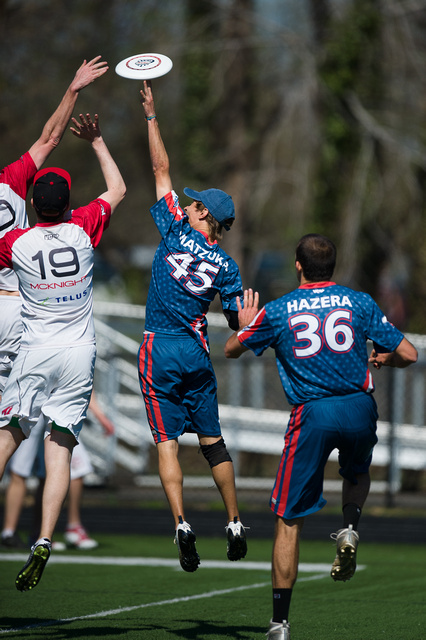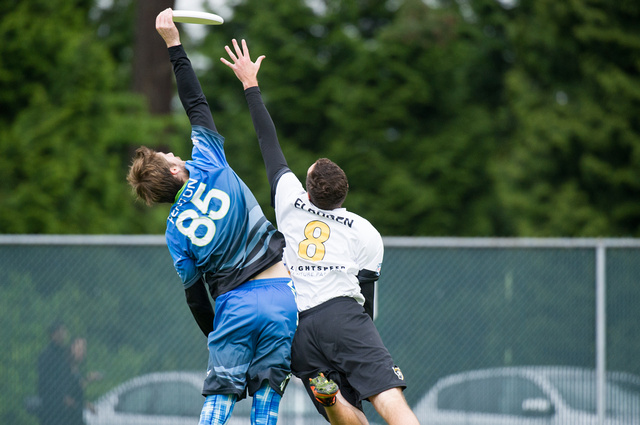
For the second year in a row Skyd selected a first and second All AUDL team. Three handlers and four cutters are named to each team. Players were selected for their overall contributions towards helping their team win games during the regular season.
Any time a team like this is selected there are challenges. Inevitably players get left off, and many contributions can’t be measured with statistics. Some of the most talented players in the league didn’t play in that many games, like Eric Johnson or Alex Thorne. Undoubtedly a selection process like this can be more art than science, but these fourteen players put together the best resumes across the 2014 season.
First Team

The Empire could always count on Noah Saul this season (Pete Guion- UltiPhotos.com)
Handler: Noah Saul, New York Empire
“Noah Saul has great throws that just seem to be perfectly timed with his cutters,” – Jean Levy-Champagne, Player/Coach of the Montreal Royal.
The Numbers: 56 Assists, 409 Completed Throws, 92% Completion Rate, 14 Goals, 13 D’s
Noah Saul had a tremendous season for the New York Empire. Though New York is known for its defense, Saul was the go to O-Line handler. The Empire often thrive on quick handler movement, and Saul is a big reason why. He finished second in the AUDL in assists while also being a viable option to go deep. The Empire would still be a playoff team without Saul, but with him they have a real opportunity this weekend to pull off an upset or two in Toronto. Saul averaged 1.53 completed throws per point, getting the assist on 21% of the points he played, while also throwing 24 hockey assists.
In two of the biggest games of the season on the road against the Breeze in DC with Saul in the lineup, New York’s O-Line converted 56% of its chances into scores and 68% of its hucks, with the Empire going 1-1. In their two games against Toronto, without Saul, the Empire lost two close games with their O-Line only converting 37% of their chances and 40% of its hucks. While having a player like Billy Katz as another handler to throw to makes things much easier, Noah Saul is the biggest difference maker for the Empire offense.
Handler: Ashlin Joye, San Jose Spiders
“Ashlin embodies well-rounded ultimate. Pick your poison: He’s an accurate, advantage-seeking thrower, can get open at will, and is a terribly smart defender. Add in height, speed, and boyish good looks, and you have someone you can build any team around,” Kevin Smith, San Jose Spiders player.
The Numbers: 45 Assists, 349 Completed Throws, 92% Completion Rate, 7 Goals, 10 D’s
Ashlin Joye didn’t have the strongest start to the season, but he definitely closed well. While initially struggling with new rules like the silent seven second stall count and double teams, Joye ended with numbers and results on par with anyone else. He led the Spiders in assists and to a 13-1 record. Joye leads a dangerous Spiders O-Line that likes to huck, and he’s a big reason why. In their three ESPN3 broadcast games against the San Francisco FlameThrowers, the San Jose O-Line completed 64% of their hucks, going 32 for 50. Over the course of the season Joye threw the assist on 18% of the points he played, averaging 1.38 completed throws per point played, with 25 hockey assists. This weekend he’ll be one of the keys for the Spiders as they go against a physical Madison zone, the likes of which they haven’t seen out west. But with his arsenal of throws, Ashlin Joye should cause Madison some headaches.
Handler: Cassidy Rasmussen, San Francisco FlameThrowers

Cassidy Rasumussen made big plays all over the field for San Francisco (Jeff Bell UltiPhotos.com)
“Cassidy consistently demonstrated more class on the field than anyone else. He was always the most outstanding performer on a team chock full of good players,” Tim Lavis, Vancouver Riptide Player/Coach.
The Numbers: 30 Assists, 283 Completed Throws, 89% Completion Rate, 23 Goals, 11 D’s
Defining Cassidy Rasmussen as a handler or cutter is a mostly useless exercise, since he did so much of everything for San Francisco. He played O-Line and D-Line. He cut and handled. He put up big hucks to Zane Rankin and came down with them from Eli Janin. His numbers don’t do his performance this season justice. He only scored on 18% of the points he played, but Rasmussen played on a very deep San Francisco team on both offense and defense, and he frequently helped his teammates score by simply timing his in cut correctly. While the FlameThrowers didn’t make it to the final four in Toronto, there is an argument to be made that they’re better than a couple teams that did qualify. Rasmussen is a big reason why.
Cutter: Beau Kittredge, San Jose Spiders
“We’ve all seen highlights of Beau skying piles and even jumping over people, but his greatest (though more subtle) impact is the amount of ground he can cover. He routinely chases down discs not even remotely meant for him, generating extra possessions for our D-line and affording us unmatched room for error on offense,” Kevin Smith, San Jose Spiders player.
The Numbers: 32 Assists, 254 Completed Throws, 93% Completion Rate, 36 Goals, 31 D’s
Much has been written about Kittredge, and he certainly left his mark on the AUDL this season. He is the de facto MVP regardless of whether or not he ends up winning the award. He is the only player in the league with a 30-30-30 season, with at least 30 goals, assists, and d’s. His 25 hockey assists show what a valuable weapon he is in red zone situations, where he can be deadly with the give and go. He “only” scored on 21% of the points he played, but that is a function of how deep this San Jose team is. With San Jose traveling to Toronto for the final four, the first thing on everyone else’s mind when they game plan for the Spiders is how they will stop (contain) Beau. And it will most likely be time wasted, because it’s just not happening.

Tyler Degirolamo played a huge role in the Breeze offense this year (Kevin Leclaire UltiPhotos.com)
Cutter: Tyler DeGirolamo, DC Breeze
“Tyler DeGirolamo is a very smart cutter, he doesn’t waste his energy on the field, but has a keen sense of when he needs to make his move. If the defense gives him an edge one way or the other, he is quick to exploit it. The offense surges when TD makes his move,” Jon Pressimone, DC Breeze player.
The Numbers: 38 Assists, 190 Completed Throws, 93% Completion Rate, 55 Goals, 11 D’s
While Beau Kittredge may be the most valuable player in the AUDL, if there’s another player that has an argument for that prize it’s DeGirolamo. DeGirolamo spent almost all of his time playing O-Line (82% of his points played) and he made the DC O-Line truly fearsome. DeGirolamo scored on 36% of the points he played. He helped previously mostly unknown players like Justin Solis, Liam Shramko, and Logan Rhyne become renowned players in the East. He was a fantastic deep option that also led his team in assists. The Breeze were a much deeper team this year, attracting many new players that contributed to a 10-4 record. But the talent at the top had a lot to do with it.
Cutter: Mark Lloyd, Toronto Rush
“Mark Lloyd is an animal. He’s got a ton of skills in his arsenal that is honed to a precise sharpness and he’s readily able to call on any or all of those in an instant. He’s definitely the heart and soul of Toronto in both his drive and his passion on the field,” Jon Pressimone, DC Breeze player.
The Numbers: 45 Assists, 294 Completed Throws, 93% Completion Rate, 46 Goals, 23 D’s
The stats show the impact Lloyd had on the Toronto Rush, leading the team to a 13-1 record. But what’s impressive about Lloyd’s performance is that so often he seemed like just one of many important cogs in the Toronto offense….until the fourth quarter. And in the fourth quarter Mark Lloyd would become the closest thing the AUDL has to Superman. Trailing late against the Empire on the road facing an upwind D point? No problem, Mark Lloyd will make the tying and go ahead assists against a wind that has made everyone else’s throws look silly. Having trouble generating turns against an efficient DC O-Line? Mark Lloyd will get the disc back for your defense when it matters most. He scored on 27% of the points he played, and averaged .88 throws per point, more average throws than either Kittredge or DeGirolamo. Last year he led Toronto to a championship. Heading into the final four at home this year, anything less than a repeat performance would be a disappointment.
Cutter: Jonathan Helton, Chicago Wildfire
“Jonathan Helton is super fast and shows up on highlight reels all the time, but when you stop and talk to him, you get to learn he’s a good natured, down to earth kind of guy, and that makes it sting even worse when he beats you because you can’t even be mad,” Ben Murphy, Detroit Mechanix player.
The Numbers: 41 Assists, 254 Completed Throws, 89% Completion Rate, 41 Goals, 13 D’s
The back-to-back MVP will most likely see his reign end in 2014, but he still put together a tremendous season. Chicago was inexplicably inconsistent this year, but Jonathan “Goose” Helton was solid throughout, scoring on 25% of the points he played. Chicago did not play a huck happy offense, but Goose was one of the players on the Wildfire that had the green light to let it fly. More frequently he was the recipient of deep looks. Helton was one of the favorite targets of Wildfire handler Bob Liu* doing whatever needed to be done, at times working many short under looks against a tight zone, or stretching it deep. And though he mostly played O-Line this year, Helton is known as one of the better defenders in the game. In a league where O-Line’s too often look passive on defense after a turn, Helton was one giant exception to that rule.
Second Team
Handler: Andrew Brown, Madison Radicals
“Andrew Brown is consistently a keystone of Madison’s offense and has a very high completion percentage,” Joey Cari, Indianapolis AlleyCats player.
The Numbers: 27 Assists, 442 Completed Throws, 98% Completion Rate, 7 Goals, 3 D’s
Andrew Brown is a rock for the Madison offense. He can be relied on like no other handler in the AUDL. With a 98% completion rate, he makes very few mistakes. Brown has an array of breaks that becomes especially useful in the 53 yard wide AUDL field. While his assist numbers may not be on par with some others, no one else is as integral to their offense as Brown is to the Radicals O-Line. He averages 2.51 throws per point. That’s nearly a full throw more than Noah Saul, who averages more throws per point than any other player on the first team. It’s also more throws per point than players like Bob Liu or An Toine of the AlleyCats, two players that their respective teams rely on. Brown has a great partner in crime in Tom Annen, who is another high efficient handler (though not at the Brown level of efficiency) that is just a little more willing to take the risky shot. They make a very effective duo for Madison.
Handler: Brett Matzuka, DC Breeze

Brett Matzuka helped DC reach the playoffs (Kevin Leclaire- UltiPhotos.com)
“Brett Matzuka is a crafty, wiley, clever man when it comes to Ultimate. His experience on the field and knowledge of how the game works allows him to make quick plays and snap decisions that benefit us on the D line,” Jon Pressimone, DC Breeze player.
The Numbers: 36 Assists, 419 Completed Throws, 93% Completion Rate, 9 Goals, 12 D’s
Matzuka filled whatever role the Breeze needed this season. When Alex Thorne and Josh Norris had to miss time, Matzuka became the primary O-Line handler for the Breeze. When the Breeze had their full squad, Matzuka became the D-Line handler that had a little more room to get creative. Matzuka averaged 1.44 throws per point, which is especially indicative of how important he was to DC considering that 64% of the points he played were on the D-Line. Despite the disappointing end to the season for DC, Matzuka played a big part in getting them to the playoffs in the first place.
Handler: Eli Janin, San Francisco FlameThrowers
The Numbers: 36 Assists, 363 Completed Throws, 90% Completion Rate, 9 Goals, 10 D’s
Janin was one of the main factors in getting the FlameThrowers offense humming this season. With an abundance of release points he was a very difficult thrower to contain, and remained cool under pressure. If Janin had the disc in his hands and a stall seemed imminent, the disc usually found an open receiver on the break side at the perfect time. With targets like Cassidy Rasmussen, Zane Rankin, and Lucas Dallman sometimes it can be hard to miss, but Janin did a good job of making their life relatively easy this year. The FlameThrowers missed Janin in the playoffs, losing to San Jose 16-26. It was their worst loss to San Jose all season. The San Francisco offense just wasn’t quite the same without him.
Cutter: Keenan Plew, Indianapolis AlleyCats
“He deserves the nod for being the jump start to the offense. He could easily fill in as a deep receiver like Cameron, but the opposite wouldn’t hold true. Quick cuts, potent throws, and always plays within himself, never forcing the issue,” Bob Liu, Chicago Wildfire player.
The Numbers: 37 Assists, 282 Completed Throws, 96% Completion Rate, 38 Goals, 5 D’s
Somehow Keenan Plew remains underrated, even after being the most valuable player on the AlleyCats for the second straight year. He undoubtedly had more help this year, with the emergence of Joey Cari, the improved play of Travis Carpenter, the arrival of An Toine, and continued production of Cameron Brock. But Plew remains the key to success for Indianapolis. He is often the igniter, finding the space that needs to be cut to at the perfect time, or finding the throw that few others on the team can make. Plew is a cutter that averages 1.07 throws per point. That’s more than any other cutter on the first or second team. He scored on 29% of the points he played, more than Kittredge, Lloyd, or Helton, and just as high as his teammate, the AUDL leading goal scorer Cameron Brock.
Cutter: James Hron, Minnesota Wind Chill
“Hron is tough to defend as he is great at using his body for ideal positioning to always have a better play on the disc than his defender,” Jared Payne, Indianapolis AlleyCats Coach
The Numbers: 35 Assists, 246 Completed Throws, 96% Completion Rate, 45 Goals, 6 D’s
James Hron was a beast for the Minnesota Wind Chill this year. He caught all sorts of goals, though a lot of them came from Kevin Seiler, 23 in fact, just over half. But Hron was more than just a product of the Wind Chill offense. He was able to get open using his speed, size, or just going to wherever the open space was, knowing his teammates (especially Seiler) could get him the disc. What made Hron different was that this year he also showed he was effective with the disc. Hron made good decisions, which meant a dump to a handler sometimes and a huck at other times. His deep throws were not especially spectacular but they were very reliable. Hron scored on 27% of the points he played, and the Wind Chill would not have been an above .500 team without him.

Derek Fenton put up numbers like nobody’s business this year (Jeff Bell- UltiPhotos.com)
Cutter: Derek Fenton, Vancouver Riptide
“Derek is the go to guy for Riptide. With a huge arsenal of throws, and the ability to frighten defenders deep himself, he was pretty unstoppable all year,” Tim Lavis, Vancouver Riptide Player/Coach.
The Numbers: 59 Assists, 149 Completed Throws, 88% Completion Rate, 44 Goals, 7 D’s
Derek Fenton put up the kind of numbers for Vancouver this year that one might expect from a well known all star. He certainly wasn’t well known before the season, but Fenton’s star is rising now. Vancouver is a young, offensive oriented team. Fenton was one of their main weapons on the O-Line, which at times played even with San Jose. He scored on 38% of the points he played, a better percentage than any other player on either the first or second team, including Tyler Degirolamo. The qualm one could have with putting Fenton on the team is that he doesn’t throw the disc nearly as often as the others here, his .56 throws per point are low for a featured O-Line receiver. His completion percentage is also lower, but at 88% he’s still more than worth the risk.
Cutter: Andrew Meshnick, Madison Radicals
“Meshnick is a big playmaker for the Madison D line. Stats speak for themselves. Their O line takes care of business, but the D slows the game down to a crawl and chews up clock,” Bob Liu, Chicago Wildfire player.
The Numbers: 23 Assists, 81 Completed Throws, 87% Completion Rate, 18 Goals, 25 D’s
Andrew Meshnick is like no other player on this list. 87% of his playing time came on the D-Line, making him more of a specialist than most other All Stars. But Meshnick is part of the 2 in the 2-4-1 Madison zone that gave the rest of the Midwest fits all season. In a league where some teams are still playing the same essential game plan as in Club, Madison definitely is a step ahead. Their zone relies on Andrew Meshnick and Matt Weber on choosing when to contain, and when to trap. Since it’s a zone that employs the double team there is nothing like it in Club Ultimate. Meshnick did have 25 D’s, but there isn’t a stat that tracks how many of the 49 D’s Peter Graffy (the deep deep in the Madison zone) had that his pressure was responsible for. Graffy has done tremendous work making athletic plays for the Madison defense, but Meshnick has done a great job in a brand new kind of role for Madison.
*Bob Liu earns a nod for the slightly less prestigious Skyd All AUDL Glue Team. Players that may not have put up big numbers or flashy plays, but were essential to their team. Other players on the All Glue team are Thomson McKnight, Joey Cari, Billy Katz, Matt Weber, Marcelo Sanchez, and the entire New York D-Line.









Comments Policy: At Skyd, we value all legitimate contributions to the discussion of ultimate. However, please ensure your input is respectful. Hateful, slanderous, or disrespectful comments will be deleted. For grammatical, factual, and typographic errors, instead of leaving a comment, please e-mail our editors directly at editors [at] skydmagazine.com.